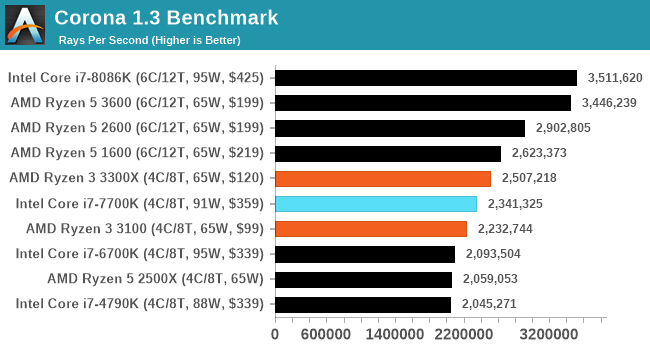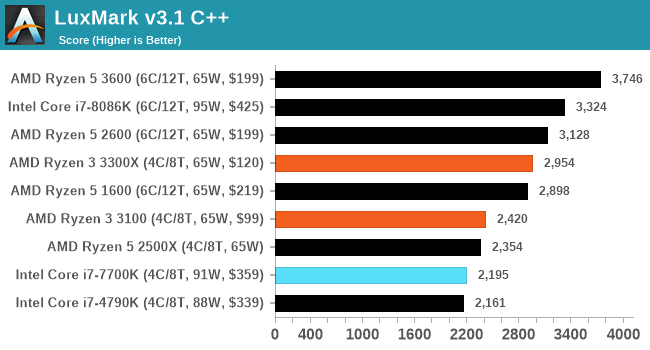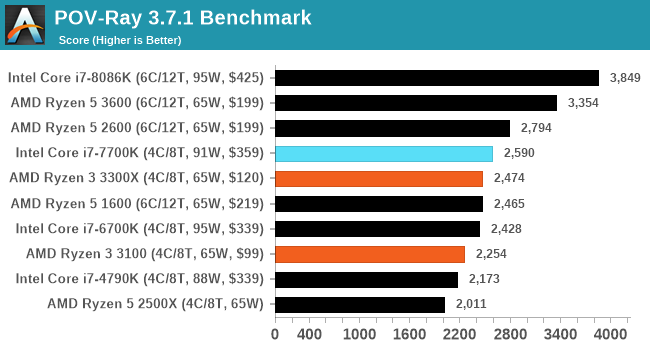The AMD Ryzen 3 3300X and 3100 CPU Review: A Budget Gaming Bonanza
by Dr. Ian Cutress on May 7, 2020 9:00 AM ESTCPU Performance: Rendering Tests
Rendering is often a key target for processor workloads, lending itself to a professional environment. It comes in different formats as well, from 3D rendering through rasterization, such as games, or by ray tracing, and invokes the ability of the software to manage meshes, textures, collisions, aliasing, physics (in animations), and discarding unnecessary work. Most renderers offer CPU code paths, while a few use GPUs and select environments use FPGAs or dedicated ASICs. For big studios however, CPUs are still the hardware of choice.
All of our benchmark results can also be found in our benchmark engine, Bench.
Corona 1.3: Performance Render
An advanced performance based renderer for software such as 3ds Max and Cinema 4D, the Corona benchmark renders a generated scene as a standard under its 1.3 software version. Normally the GUI implementation of the benchmark shows the scene being built, and allows the user to upload the result as a ‘time to complete’.
We got in contact with the developer who gave us a command line version of the benchmark that does a direct output of results. Rather than reporting time, we report the average number of rays per second across six runs, as the performance scaling of a result per unit time is typically visually easier to understand.
The Corona benchmark website can be found at https://corona-renderer.com/benchmark

LuxMark v3.1: LuxRender via Different Code Paths
As stated at the top, there are many different ways to process rendering data: CPU, GPU, Accelerator, and others. On top of that, there are many frameworks and APIs in which to program, depending on how the software will be used. LuxMark, a benchmark developed using the LuxRender engine, offers several different scenes and APIs.
In our test, we run the simple ‘Ball’ scene on both the C++ and OpenCL code paths, but in CPU mode. This scene starts with a rough render and slowly improves the quality over two minutes, giving a final result in what is essentially an average ‘kilorays per second’.

POV-Ray 3.7.1: Ray Tracing
The Persistence of Vision ray tracing engine is another well-known benchmarking tool, which was in a state of relative hibernation until AMD released its Zen processors, to which suddenly both Intel and AMD were submitting code to the main branch of the open source project. For our test, we use the built-in benchmark for all-cores, called from the command line.
POV-Ray can be downloaded from http://www.povray.org/












249 Comments
View All Comments
Korguz - Thursday, May 7, 2020 - link
well maxipadking, if this site pisses you off so much, and all you do is whine about how bad the reviews are, and how they test low end garbage cpus, why do you even bother coming here ? it is just to be a biased intel shill ?? go back the site that praises your god intel.Deicidium369 - Friday, May 8, 2020 - link
Look it's the resident, no life AMD shill in his natural habitat - offering absolutely nothing to conversation and just sniping.. he will also follow you to other forums - he's a creepy little guyKorguz - Friday, May 8, 2020 - link
your funny man, go look in the mirror, and work on getting your OWN personal facts straight.Spunjji - Monday, May 11, 2020 - link
I am enjoying how "I got caught shitposting in multiple forums" went through Deicidium's flamebot troll filter and came out as "watch out, this guy will stalk you".dwade123 - Thursday, May 7, 2020 - link
It’s crazy how Skylake is still the fastest for gaming. Beats having to spend and spend on endless minor upgrades with AMD... and still be slower in gaming ROFL.Makaveli - Thursday, May 7, 2020 - link
And maybe that matters to man children who never leave the basement. For the rest of the adults, price/performance matters more than a few extra fps. And even more so now with alot of people being layed off due to the pandemic and trying to save money.stardude82 - Thursday, May 7, 2020 - link
Heck, for most people a 10 year old Lynn field is good enough.rUmX - Saturday, May 9, 2020 - link
I just recently rebuilt a i5 760 for a friend, and you're absolutely right. It is still a pretty quick cpu for most users for basic tasks. However its super slow compared to even Zen 1. Part of that is the low clocks, and lacking boost. My Ryzen 1600 non-AF runs circles around it even single threaded.Spunjji - Monday, May 11, 2020 - link
When the best reach you can manage is "My favourite company's abject failure to improve performance is a plus, actually."ExarKun333 - Thursday, May 7, 2020 - link
This is AMD 90nm all over again.